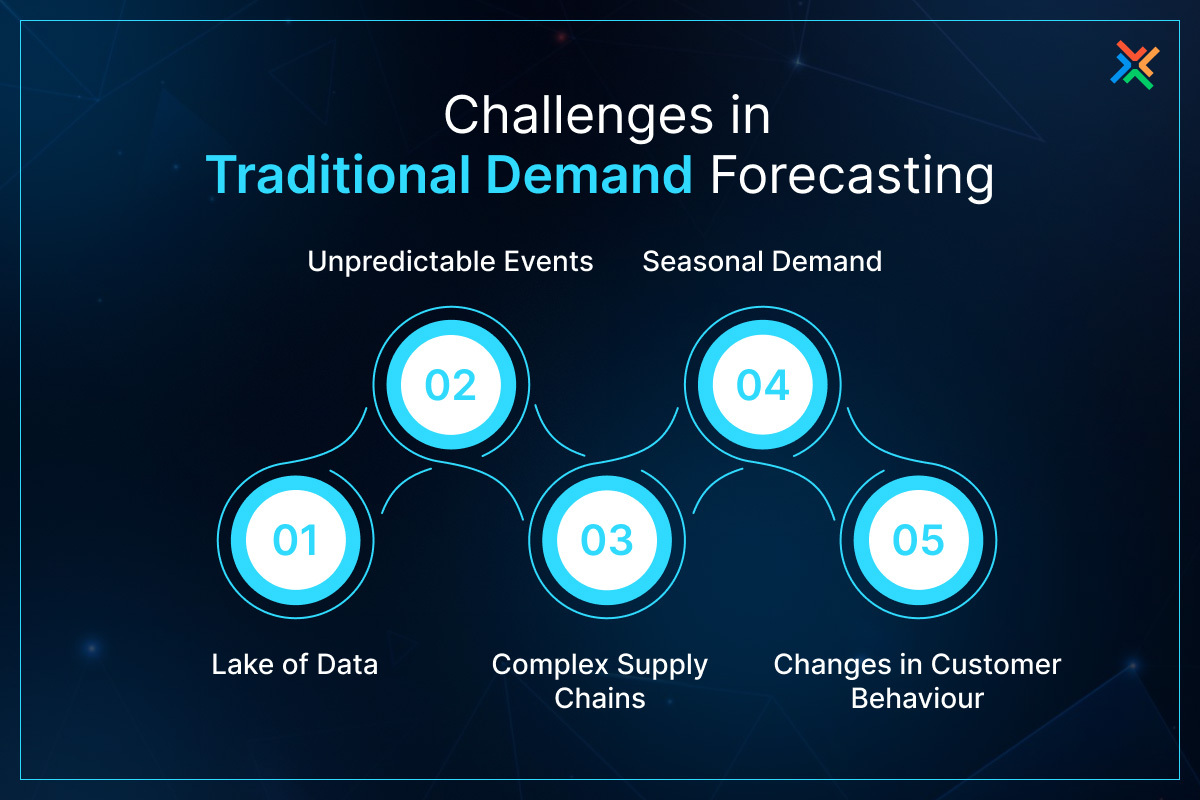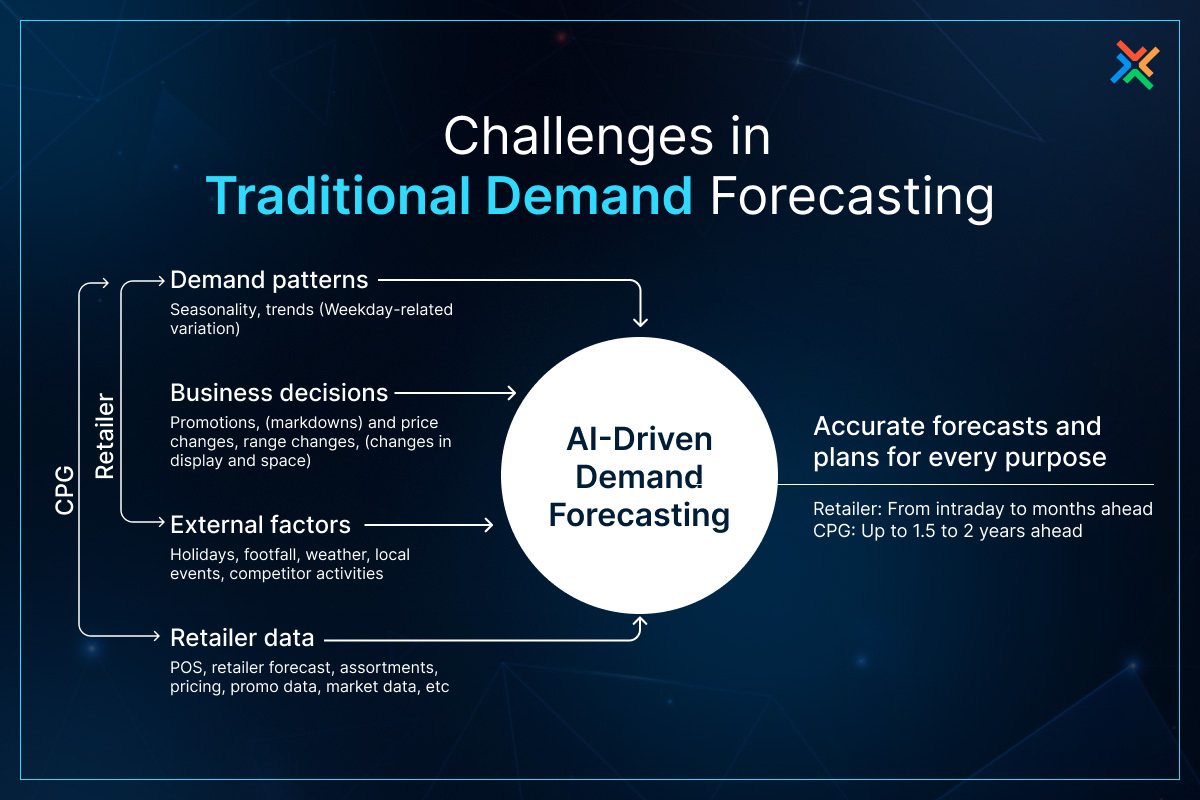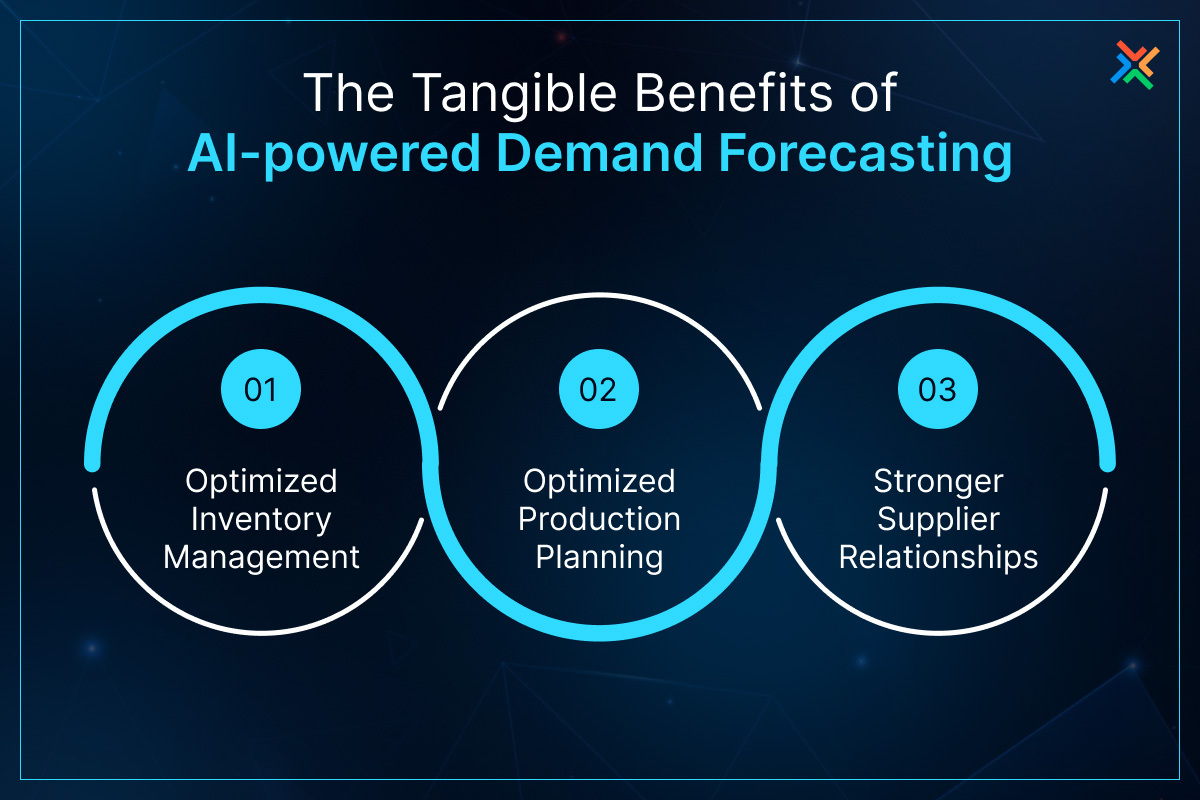Transforming Supply Chain Management: The Impact of AI on Demand Forecasting
August 02, 2024

Vivek Adatia
.jpg?w=1920&q=75)
Considering how dynamic the market is today, it is a constant struggle for supply chain professionals to have the right amount of inventory at the right time. Underestimating seasonal demand can lead to frustrating stockouts, leaving customers empty-handed and damaging the brand’s reputation. Conversely, overstocking ties up valuable resources, leading to wasted storage space, product obsolescence, and unnecessary financial burden.
Traditional demand forecasting methods, often reliant on historical data and statistical models, can struggle to keep pace with dynamic market demands. Unexpected events, like sudden shifts in consumer preferences or disruptions in the global supply chain, can throw off even the most carefully crafted forecasts. However, AI-powered demand forecasting is revolutionizing supply chain management, providing businesses with tools to achieve a level of accuracy and agility previously unimaginable.
The Bottlenecks of Traditional Demand Forecasting

While traditional forecasting methods like time-series analysis and moving averages have served businesses well for decades, they struggle to keep pace with the market complexities. These methods often rely on historical sales data to predict future trends. However, the sheer volume and variety of data relevant to demand forecasting have grown exponentially.
Modern consumers are influenced by a myriad of factors other than just past purchases. Social media trends, economic indicators, competitor activities, and even weather patterns can all significantly impact demand. Traditional methods struggle to incorporate and analyze these large, complex datasets, leading to forecasts that are often incomplete and inaccurate.
The consequences of inaccurate forecasts can be substantial. Underestimating demand can result in stockouts, frustrating customers and potentially leading to lost sales opportunities. This can be particularly damaging for businesses with seasonal products or those operating in a competitive domain.
On the other hand, overestimating demand leads to excess inventory. This not only ties up valuable working capital in storage space and product management, but it also increases the risk of product obsolescence, especially for products with short lifespans or those susceptible to changing consumer preferences. This reinstates the fact that the ability to accurately forecast demand is a critical factor for achieving supply chain efficiency and profitability.
AI-powered Demand Forecasting as a Solution

AI, or Artificial Intelligence, refers to a branch of computer science focused on developing intelligent machines that can learn and solve problems. Within AI development services in the UAE, Machine Learning (ML) plays a central role. ML algorithms can analyze large datasets, uncovering hidden patterns and trends that would be impossible to detect through traditional means. For instance:
- Internal data: Historical sales figures, inventory levels, and customer behavior patterns.
- External data: Economic indicators, social media sentiment, competitor activity, weather forecasts, and even global events.
Through a process called neural networks, AI can learn from this data, identifying complex patterns and trends that might go unnoticed by humans. These neural networks mimic the structure of the human brain, constantly learning and improving their forecasting accuracy.
Furthermore, AI utilizes techniques like anomaly detection to identify unexpected shifts in demand patterns, allowing businesses to quickly adapt to changing market conditions. Additionally, AI excels at time series analysis, a technique crucial for understanding seasonal trends and cyclical patterns in demand data.
There are various AI models particularly adept at demand forecasting.
- Recurrent Neural Networks (RNNs): These models are highly effective at capturing sequential data and handling seasonality. RNNs excel at understanding the order and relationships within data points, making them ideal for forecasting trends that repeat over time.
- Convolutional Neural Networks (CNNs): CNNs are particularly useful for identifying patterns in complex, multi-dimensional data. This makes them valuable for analyzing external data sources like social media sentiment or weather forecasts, which can significantly impact demand.
Alongside these established techniques, even more advanced AI approaches are coming up.
- Generative AI: This approach allows AI models to create realistic simulations of future demand scenarios based on various market conditions. This allows businesses to test different strategies and make more informed decisions about inventory management and production planning.
How AI Integrates External Factors
One of the most significant advantages of AI-powered demand forecasting is its ability to consider a wider range of external factors that can influence demand.
- Economic Indicators: AI analyzes GDP growth, consumer confidence, and inflation to predict spending habits.
- Social Media Trends: It scours social media for brand mentions, sentiment analysis, and trending topics to anticipate demand shifts and identify potential issues.
- Weather Patterns: For weather-sensitive products, AI integrates weather forecasts to predict demand fluctuations.
- Global Events: News feeds and event data are analyzed to account for disruptions caused by pandemics, political unrest, or natural disasters.
These external factors are not analyzed in isolation. AI integrates all this data – historical sales figures, internal data, and a wide range of external factors – into a single, unified model. This allows it to identify complex relationships between these variables and create a more comprehensive picture of future demand.
For instance, AI might detect a correlation between positive social media sentiment for a new product launch and a surge in demand for similar products from your competitors. This insight can help you adjust production plans or marketing strategies to capitalize on the emerging trend.
The Tangible Benefits of AI-powered Demand Forecasting
AI offers measurable benefits for businesses. Industry benchmarks suggest that AI implementation can lead to considerable improvements in forecast accuracy, often exceeding 30% compared to traditional methods. This translates to a substantial reduction in forecast errors, leading to a chain reaction of positive outcomes.

Optimized Inventory Management
By providing more accurate forecasts, AI development service providers in the UAE help businesses maintain optimal inventory levels. This reduces the risk of stockouts, boosting customer satisfaction and minimizing lost sales opportunities. At the same time, it minimizes the amount of unnecessary inventory held, leading to reduced storage costs, waste from obsolescence, and improved cash flow.
Optimized Production Planning
Accurate forecasts help businesses plan production more efficiently. Knowing the anticipated demand allows for better resource allocation, ensuring production capacity meets demand without unnecessary waste. This leads to improved delivery times and a more responsive supply chain overall.
Stronger Supplier Relationships
With a clearer picture of future demand, businesses can collaborate more effectively with suppliers. Accurate forecasts allow for more predictable ordering patterns, which benefits both parties. Suppliers can plan production more efficiently, and businesses can eliminate the risk of disruptions caused by supply shortages. This encourages stronger supplier relationships and a more resilient supply chain.
Implementation Considerations
While AI-powered demand forecasting offers numerous benefits, its implementation requires careful consideration of several key challenges.
Data Quality and Availability
AI models are only as good as the data they're trained on. Inaccurate or incomplete data can lead to biased forecasts. Businesses need to make sure they have access to clean, organized, and comprehensive data sets for model training.
- Solution: Implementing data cleansing strategies to identify and rectify errors becomes crucial. Establishing clear data governance practices makes sure data quality is maintained throughout the process.
Integration with Existing Systems
Integrating AI solutions with existing supply chain management infrastructure can be a hurdle. Effective data exchange between the new AI system and existing platforms is essential for effective forecasting.
- Solution: Utilizing open-ended Application Programming Interfaces (APIs) facilitates smoother data exchange. This allows for flexible integration with diverse existing systems, minimizing disruption and maximizing efficiency.
Change Management
Shifting from traditional methods to supply chain management with AI can lead to resistance from teams accustomed to established workflows. Effectively communicating the benefits of AI and its potential impact on overall efficiency is key.
- Solution: Investing in training and support programs provides teams with the knowledge and skills to utilize AI effectively. This promotes a culture of data-driven decision-making and helps teams adapt to the dynamic ecosystem.
The Future of AI in Demand Forecasting
Several trends are set to shape the future of AI in demand forecasting.
- Merging with Automation: Integration with Robotic Process Automation (RPA) will optimize the forecasting process even further. RPA automates repetitive tasks like data collection and cleaning, freeing up human resources to focus on higher-level analysis and strategic planning.
- Transparency through Explainability: As AI models become more complex, Explainable AI (XAI) will play a crucial role. XAI techniques aim to make AI models' decision-making processes more transparent and understandable. This will increase trust in AI-generated forecasts and allow businesses to harness them with greater confidence.
- Generative Forecasting: Generative AI can be used to create entirely new product forecasts based on market trends, customer preferences, and historical data. This allows businesses to proactively identify potential opportunities and develop data-driven strategies for market success.
These advancements signal a future where AI becomes an even more powerful tool for optimizing supply chains and achieving unparalleled forecast accuracy.
Collaborate with WDCS to implement AI in Supply Chain Demand Forecasting
WDCS Technology is a leading AI development company in the UAE, providing advanced solutions designed to reinvent your supply chain. Explore our suite of AI-powered demand forecasting solutions or contact us today for a personalized consultation. Our team of AI experts can help your business achieve optimal inventory levels, optimize production, and ultimately, gain a significant edge in the marketplace.
Partner with WDCS to harness AI-powered demand forecasting in your supply chain business.
Experience the future of supply chain management with WDCS. Our AI-powered demand forecasting solutions provide actionable insights to optimize inventory, optimize operations, and drive growth.